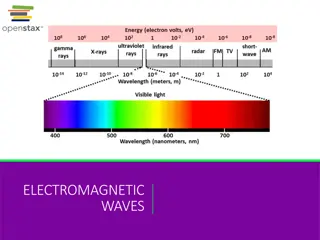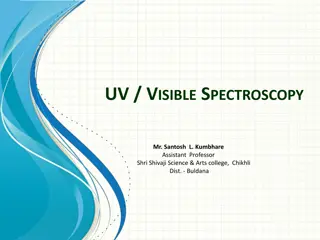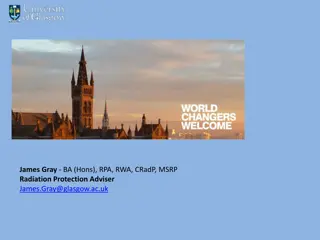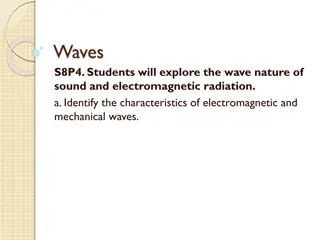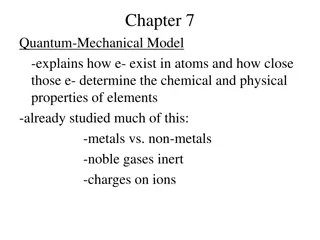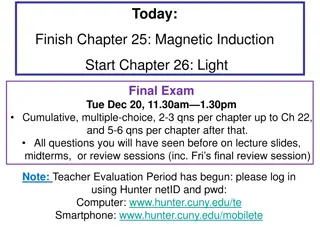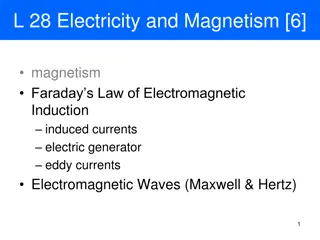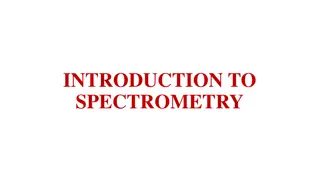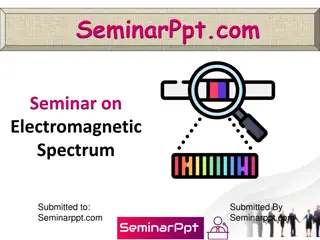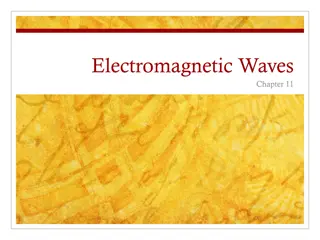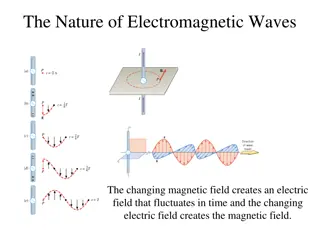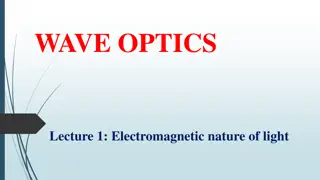Electromagnetic Waves: Maxwell's Contributions and Hertz's Observations
James Clerk Maxwell's groundbreaking work in the 19th century revealed the fundamental nature of light as an electromagnetic wave. His equations formed the basis for understanding the interplay between electricity and magnetism, predicting the existence of electromagnetic waves. Heinrich Hertz furth
11 views • 24 slides
Electromagnetic Surveying Methods and Applications
Electromagnetic surveying, conducted by Dr. Laurent Marescot, utilizes various methods like resistivity, induced polarization, and high-frequency techniques for exploration and investigation purposes. The electromagnetic method involves generating primary fields and detecting secondary fields to ana
7 views • 55 slides
Electromagnetic Radiation and its Properties
This educational content delves into the arrangement of electrons in atoms, focusing on the properties of light and the electromagnetic spectrum, including the visible light spectrum. It explains wavelike behavior, wavelength, frequency, and their mathematical relationship, providing practice questi
5 views • 39 slides
UV/Visible Spectroscopy and Electromagnetic Radiation
Spectroscopy is the study of the interaction of matter with light, specifically UV and visible radiation. Electromagnetic radiation, consisting of photons, transmits energy through space as waves with oscillating electric and magnetic fields. The relationship between wavelength and frequency is key,
2 views • 50 slides
Electromagnetic Waves: A Comprehensive Overview
Introduction to plane waves, the electromagnetic spectrum, TV and radio spectrum, and a comparison of wired and wireless systems. Discusses the properties and applications of various frequency ranges within the electromagnetic spectrum. Highlights the efficiency of wireless systems over wired system
6 views • 37 slides
Managing Electromagnetic Fields in the Workplace: Regulations and Guidelines
James Gray, an experienced Radiation Protection Adviser, provides insights on the Control of Electromagnetic Fields at Work Regulations. The content covers definitions, health effects, direct and indirect effects, and necessary actions to ensure workplace safety regarding EMFs exposure.
6 views • 19 slides
Unveiling the World of Electromagnetic Waves
Delve into the omnipresence of electromagnetic radiation with engaging activities that explore the characteristics of the electromagnetic spectrum, devices utilizing electromagnetic waves, and the mechanisms behind their functionality. Enhance your understanding by partaking in interactive learning
5 views • 7 slides
The Wave Theory of Light and Electromagnetic Spectrum
Explore the fascinating world of electromagnetic waves, visible light, and the wave theory through concepts such as wavelength, frequency, amplitude, and the speed of light. Understand how these elements are interconnected, and discover the diverse range of the electromagnetic spectrum. Dive into th
4 views • 77 slides
Waves: Characteristics and Types Explained
Explore the wave nature of sound and electromagnetic radiation, distinguishing between electromagnetic and mechanical waves. Waves are energy-carrying disturbances that do not transport matter. Mechanical waves require a medium for energy transfer, while electromagnetic waves can travel through spac
3 views • 26 slides
Larmor's Theorem and Lagrangian Formulation in Electromagnetic Fields
Explore Larmor's Theorem, time-averaged forces, torques, and Lagrangian formulations for systems of charges in electromagnetic fields. Dive into the comparison with electric dipoles, transformation to rotating frames, and Lagrangian analysis for closed systems with finite motions. Uncover the intric
3 views • 13 slides
Harmonics in Electromagnetic Environments
In the realm of electromagnetic environments, the generation of electromagnetic interference (EMI) through harmonics plays a crucial role. This article delves into the concept of harmonics, their generation in simple DC power supplies, and the impact they have on electronic devices. From the basics
8 views • 31 slides
Quantum-Mechanical Model and Electromagnetic Waves
Quantum-Mechanical Model delves into how electrons exist in atoms, shaping the chemical and physical properties of elements. It contrasts metals and non-metals, emphasizes noble gases' inertness, and explains the charges on ions. Additionally, it explores the similarities between electrons and light
5 views • 33 slides
Electromagnetic Waves and Their Velocity
Light, as a transverse wave, is a part of the electromagnetic spectrum produced by accelerating electrons. Electromagnetic waves originate from vibrating charges, creating a continuous cycle of electric and magnetic fields. The velocity of electromagnetic waves is constant due to energy conservation
6 views • 32 slides
Magnetism: Faraday's Law and Electromagnetic Induction
Explore the fascinating world of magnetism and electromagnetism with insights into Faraday's Law of Electromagnetic Induction, induced currents, and the basic principles of magnetism. Discover how a changing magnetic field can produce a current and unravel the key concepts behind electromagnetic wav
4 views • 24 slides
Spectrometry and Electromagnetic Waves
Spectrometry plays a vital role in analytical chemistry by studying the interactions of radiation and matter through electromagnetic waves. These waves, characterized by varying electric and magnetic fields, travel at the speed of light in vacuum with a constant velocity. The properties and characte
4 views • 24 slides
The Electromagnetic Spectrum: A Comprehensive Overview
The electromagnetic spectrum encompasses a vast range of frequencies and wavelengths of electromagnetic radiation. This seminar presentation delves into the definition, uses, significance, and formulas associated with the electromagnetic spectrum. Covering topics from radio waves to cosmic rays, it
6 views • 20 slides
Electromagnetic Waves: Essential Concepts and Applications
Electromagnetic waves are a fundamental aspect of physics, characterized by the transmission of energy through vibrating electric and magnetic fields. This comprehensive guide explores the production, properties, and applications of electromagnetic waves, shedding light on topics such as photon beha
5 views • 21 slides
Electromagnetic Waves: Speed, Spectrum, and Applications
Electromagnetic waves are characterized by the interplay between changing magnetic and electric fields, propagating at the speed of light in a vacuum. This speed, denoted by 'c,' is a fundamental constant. The electromagnetic spectrum encompasses a range of frequencies and applications, from radio a
2 views • 12 slides
The Electromagnetic Nature of Light in Wave Optics
Exploring the electromagnetic properties of light, this lecture covers the dual nature of light as both a wave and particles, the quantized particle nature of light known as photons, and the manifestation of the electromagnetic nature of light through Maxwell's equations. It delves into wavefronts,
9 views • 8 slides
Electromagnetic Waves and Radar Systems
Dive into the world of electromagnetic waves and radar systems with detailed explanations on wave basics, the electromagnetic spectrum, radar technology, and applications in geometry. Discover how radio waves are used in radar systems and the importance of electromagnetic energy in modern engineerin
7 views • 13 slides
Electromagnetic Waves in Physics
Exploring the propagation of electromagnetic waves in different mediums such as free space and isotropic dielectrics. Discusses Maxwell's equations, wave equations, transverse nature, energy transmission, and impedance in electromagnetic wave propagation.
0 views • 24 slides
Electromagnetic Testing (ET) in NDT
Electromagnetic Testing (ET) is a crucial NDT method involving techniques like Eddy Current Testing (ECT) and Alternating Current Field Measurement (ACFM). It is used for crack detection, material thickness measurement, and more in various industries due to its sensitivity and immediate results. Des
2 views • 21 slides
Intermediate EM Waves: Vector Wave Equations and Waveguide Fields
The vector wave equations and waveguide fields in intermediate electromagnetic waves, as discussed in Prof. David R. Jackson's fall 2016 ECE 6340 course notes. Learn about the wave equation, Laplacian, Helmholtz equation, and wave impedance in the context of electromagnetic wave propagation.
2 views • 17 slides
Radiation from Aperture in Cylinder
This text discusses the radiation from an aperture in a cylinder, exploring mathematical equations and transformations related to electromagnetic fields. It covers principles of wave propagation using cylindrical transforms, along with calculations and derivations involved in the electromagnetic ana
5 views • 27 slides
Electromagnetic Induction Explained: Production of Voltage & Current
Electromagnetic induction is the process of generating an electromotive force in a conductor within a changing magnetic field. This phenomenon, first discovered by Michael Faraday, has various practical applications in electrical components such as inductors and transformers, as well as in devices l
2 views • 32 slides
Electromagnetic Induction in Electric Guitars
Electric guitars utilize electromagnetic pickups beneath the strings to produce sound through the process of electromagnetic induction. This phenomenon involves inducing an EMF in a coil of wire using a magnet, creating a current when the magnet moves relative to the coil. The concept of magnetic fl
3 views • 17 slides
Announcements
Faraday's speculation connecting light to electricity and magnetism led to Maxwell's groundbreaking understanding of light as an oscillation of the electromagnetic field. Maxwell's equations revolutionized our comprehension of electromagnetic waves, revealing their ability to exist at any wavelength
1 views • 17 slides
Bineswar Brahma Engineering College
This content explores Electromagnetic Field Theory, discussing concepts like fields, static electric and magnetic fields, differences between Circuit Theory and Field Theory, applications, and scalar quantities. It delves into the fundamental principles and applications of electromagnetic fields in
1 views • 19 slides
Significance of Electromagnetic Waves in Electrical Engineering
Delve into the fundamental importance of electromagnetic waves in the realm of electrical sciences and engineering. Explore applications, course themes, and specialized areas that rely on an understanding of electromagnetic phenomena. Prepare for a comprehensive journey through the world of waves an
2 views • 15 slides
Electromagnetic Waves, Electricity, and Magnetism
Explore the fascinating world of electromagnetic waves, electricity, and magnetism in this crash course on physical science. Learn about the properties of electromagnetic waves, how electricity works, and the principles of magnetism. Discover the electromagnetic spectrum, reflection, refraction, pol
1 views • 16 slides
Computing Radiation Fields in Antennas
Explore the computation of radiation fields in antennas, covering topics like energy flux, directivity, effective area, and antenna equivalent circuits. Understand the relationship between electric and magnetic fields and the properties of radiation vectors. Discover the significance of Ampere's law
3 views • 47 slides
Waves, Electromagnetic Radiation, and Energy
Explore the fundamentals of waves, electromagnetic radiation, momentum, energy, and photons. Learn about the key features of waves and electromagnetic radiation, their behavior, properties, and applications in various fields like sound waves and visible light. Delve into the fascinating world of ele
1 views • 10 slides
Electrodynamics, Electromagnetic Waves, and Relativity in Physics Paper-II
Explore the intricate topics of electrodynamics, electromagnetic waves, and relativity in Physics Paper-II for B.Sc. Part-III students. Delve into motion of charged particles, Faraday's law, electromagnetic potentials, Maxwell's equations, electromagnetic waves, radiation, the Lorentz transformation
6 views • 4 slides
Electromagnetic Waves and Maxwell's Equations
Explore the fascinating world of electromagnetic waves and Maxwell's equations, which unify electricity and magnetism into a single theory. Learn about the production of EM waves, energy transport, and the electromagnetic spectrum. Discover how Maxwell's equations describe the generation of electric
1 views • 33 slides
Electromagnetic Fields with Electric and Chiral Conductivities in Heavy-Ion Collisions
Explore the intricate dynamics of electromagnetic fields in heavy-ion collisions, focusing on electric and chiral magnetic conductivities. Delve into the framework for solving these fields, analytical and numerical results, and the implications of magnetic strength in such collisions. Gain insights
3 views • 21 slides
Resolving Retarded Potentials and Fourier Components in Electromagnetic Fields
Explore the spectral resolution and Fourier expansions of retarded potentials, electromagnetic waves, and moving charges. Understand the differential equations and Fourier coefficients for scalar potentials in the context of electromagnetic field theory.
2 views • 8 slides
Solving Maxwells Equations in Lorentz Gauge for Moving Point Particles
Explore the solutions of Maxwell's equations in the Lorentz gauge, focusing on Liénard-Wiechert potentials and fields for moving point particles. Delve into the determination of scalar and vector potentials, considering the electromagnetic fields generated by a point charge moving along a trajector
4 views • 35 slides
Understanding Electromagnetic Waves and Maxwell's Equations
Delve into the fascinating realm of electromagnetic waves and Maxwell's equations as we explore the sources of radiation, dipole radiation patterns, and the formulation of Maxwell's equations in terms of vector and scalar potentials. Discover the intricacies of Lorentz gauge, solutions for the elect
0 views • 20 slides
Electromagnetic Waves and Fields Overview
Explore the principles of electromagnetic waves and fields, including Malus's Law, polarizers, analyzers, and electromagnetic induction. Discover how polarizing filters affect light intensity and how electromagnetic waves are polarized. Learn about the B-Field in magnetism and electromagnetic wave p
2 views • 12 slides
Understanding Electromagnetic Radiation in Spectroscopy
Explore the world of spectroscopy through the study of electromagnetic radiation, including UV and visible spectrums. Learn about the interaction of matter with light, electromagnetic fields, frequency, and wavelength relationships in this fascinating branch of science.
1 views • 50 slides
